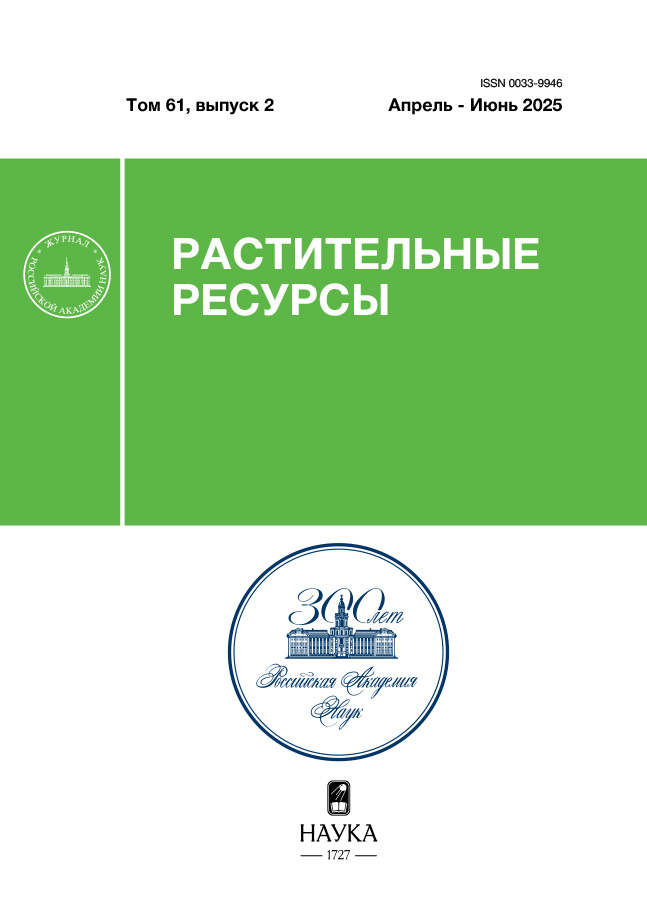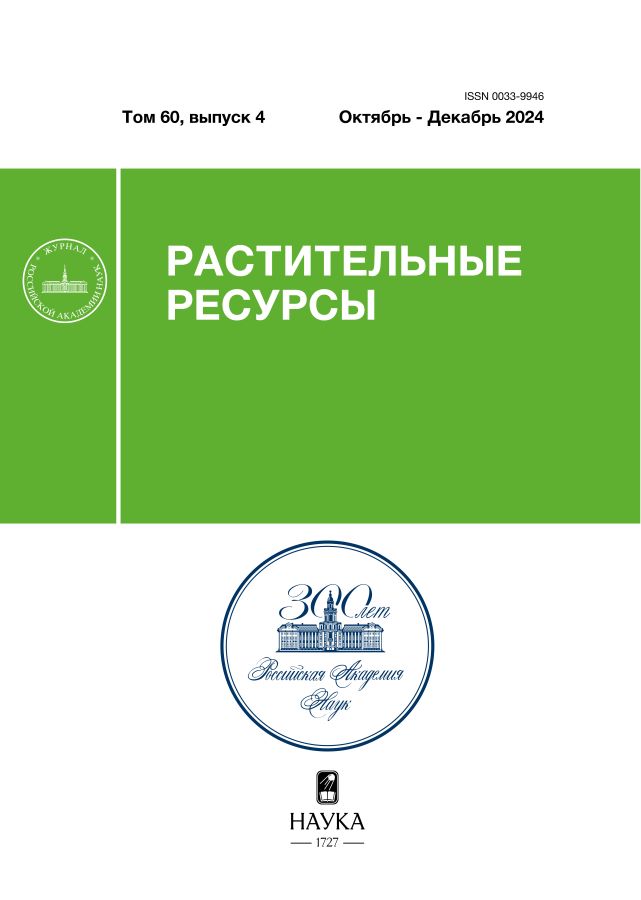Pollen of some melliferous and pollen-bearing species of the Asteraceae family in the North-West of Russia
- Authors: Braga M.V.1, Grigorjeva V.V.1, Меdvedeva N.A.1,2, Britski D.A.1, Gavrilova O.A.1
-
Affiliations:
- Komarov Botanical Institute
- Herzen State Pedagogical University
- Issue: Vol 60, No 4 (2024)
- Pages: 99-111
- Section: Biology of Resource Species
- URL: https://permmedjournal.ru/0033-9946/article/view/683286
- DOI: https://doi.org/10.31857/S0033994624040066
- EDN: https://elibrary.ru/PQUKRR
- ID: 683286
Cite item
Abstract
Using light, scanning electron and confocal laser scanning microscopes, the pollen morphology of 23 wild and introduced melliferous plant species belonging to 21 genera of the Asteraceae family, which are widely distributed in the Leningrad, Novgorod, and Pskov regions was studied. It was found that pollen grains of all the studied species are of medium size, from 18 to 50 microns, 3-aperturate, with an echinate or echinolophate type of exine. Dispersed in honey, pollen is easily determined to the family, subfamily and often to the tribe and genus. The obtained data will help honey producers to identify the pollen of the Asteraceae family plants in the tested honey samples.
Keywords
About the authors
M. V. Braga
Komarov Botanical Institute
Author for correspondence.
Email: namedvedeva@mail.ru
Russian Federation, St. Petersburg
V. V. Grigorjeva
Komarov Botanical Institute
Email: namedvedeva@mail.ru
Russian Federation, St. Petersburg
N. A. Меdvedeva
Komarov Botanical Institute; Herzen State Pedagogical University
Email: namedvedeva@mail.ru
Russian Federation, St. Petersburg; St. Petersburg
D. A. Britski
Komarov Botanical Institute
Email: namedvedeva@mail.ru
Russian Federation, St. Petersburg
O. A. Gavrilova
Komarov Botanical Institute
Email: namedvedeva@mail.ru
Russian Federation, St. Petersburg
References
- Kartashova N. N. 1955. [Honey plants of the Tomsk Region]. Tomsk. 80 p. (In Russian).
- Vereshchagin V. I. 1961. [Honey plants of the Altai Territory]. Barnaul. 100 p. (In Russian)
- Glukhov M. M. 1974. [Honey plants. 7th ed.]. Moscow. 303 p. (In Russian)
- Pelmenev V. K. 1985. [Honey plants]. Moscow. 144p. (In Russian)
- Chauhan M. S., Farooqui A., Trivedi A. 2017. Plants foraged by bees for honey production in northern India: The diverse flora of India and its implications for apiculture. — Acta Palaeobot. 57(1): 119–132. https://doi.org/10.1515/acpa-2017-0003
- Kurmanov R. G. 2020. Use of palynological and physico-chemical analysis methods in the characterization of Russian monofloral honey types. — Vestnik of Omsk SAU. 3(39): 58–65. https://elibrary.ru/wqkzbx (In Russian).
- Burmistrov A. N., Nikitina V. A. 1990. [Honey plants and their pollen]. Moscow. 73c. (In Russian).
- Gorlachev V. P., Reshetova S. A. 2013. Organoleptic and palynological assessment of some local honey from Zabaikalsky Kray. — Transbaikal State University Journal. 6(97): 3–7. https://elibrary.ru/sdjdfl (In Russian)
- Rasoloarijao T. M., Ramavovololon P., Ramamonjisoa R., Clemencet J., Lebreton G., Delatte H. 2019. Pollen morphology of melliferous plants for Apis mellifera unicolor in the tropical rainforest of Ranomafana National Park, Madagascar. —Palynology. 43(2): 292–320. https://doi.org/10.1080/01916122.2018.1443980
- Chepurnoy I. P., Rusakova T. M. 1981. [Determination of the botanical origin of honey]. — Pchelovodstvo. 9: 25–26. (In Russian)
- Kurmanov R. G., Galeev R. I. 2021. Mapping honeylands of the European part of Russia. — Moscow University Bulletin. Series 5. Geography. 3: 77–85. https://elibrary.ru/qowmbk (In Russian)
- Shukla V., Kumar A. 2020. Melissopalynological and physicochemical analysis of honey samples from Prayagraj District, Uttar Pradesh. — Acta Palaeobot. 60(1): 123–133. https://doi.org/10.35535/acpa-2020-0004
- Vaissière B. E., Vinson S. B. 1994. Pollen morphology and its effect on pollen collection by honey bees, Apis mellifera L. (Hymenoptera: Apidae), with special reference to upland cotton, Gossypium hirsutum L. (Malvaceae). — Grana. 33(3): 128–138. https://doi.org/10.1080/00173139409428989
- Tsvelev N. N. 2000. Manual of the vascular plants of North-West Russia (Leningrad, Pskov and Novgorod provinces). St. Petersburg. 781 p. (In Russian)
- [Red Data Book of the Leningrad Region: the plant world]. 2018. St. Petersburg. 848 p. (In Russian)
- [Red Data Book of the Novgorod Region]. 2015. St. Petersburg. 479 p. (In Russian)
- [Red Data Book of the Pskov Region]. 2014. Pskov. 543 p. (In Russian)
- GOST RF 19792-2017 [“Natural honey. Technical conditions”]. 17 p. https://docs.cntd.ru/document/1200157439 (In Russian)
- Skvarla J. J., Turner B. L. 1966. Systematic implications from electron microscopic studies of Compositae pollen. A review. — Ann. Missouri Bot. Garden. 53: 220–256. https://www.biodiversitylibrary.org/page/20103577
- Bolick M. R. 1978. Taxonomic, evolutionary, and functional considerations of Compositae pollen ultrastructure and sculpture. — Plant Syst. Evol. 130(3–4): 209–218. https://doi.org/10.1007/BF00982805
- Blackmore S. A., Wortley A. H., Skvarla J. J., Gabarayeva N. I., Rowley J. R. 2010. Developmental origins of structural diversity in pollen walls of Compositae. — Plant Syst. Evol. 284(1): 17–32. https://doi.org/10.1007/s00606-009-0232-2
- Bahadur S., Taj S., Long, W., Ahmad M. 2022. Pollen morphology and its implication in the taxonomy of some selected tribes of the Asteraceae of Hainan Island South China. — Bot. Rev. 88(3): 271–298. https://doi.org/10.1007/s12229-022-09277-3
- Hayat K., Khan W. M., Khan M. N., Shah S. N. 2023. Pollen morphological investigation of selected species of family Asteraceae from Pakistan by using light and scanning electron microscopy. — Microsc. Res. Tech. 86(10): 1258–1273. https://doi.org/10.1002/jemt.24308
- Askerova R. K. 1987. [Palynology of chicory. Compositae: Cichorioideae]. Baku. 208 p. (In Russian)
- Blackmore S. A. 1982a. A functional interpretation of Lactuceae (Compositae) pollen. — Pl. Syst. Evol. 141(2): 153–168. https://doi.org/10.1007/BF00986415
- Blackmore S. 1982b. Palynology of subtribe Scorzonerinae (Compositae: Lactuceae) and its taxonomic significance. — Grana. 21(3): 149–160. https://doi.org/10.1080/00173138209427691
- Wang H., Wortley A. H., Blackmore S. 2009. Pollen morphology of Crepidinae and Lactucinae (Asteraceae: Cichorieae) and its systematic significance. — Grana. 48(3):160–178. https://doi.org/10.1080/00173130902931209
- Grigorieva V. V., Korobkov A. A., Britsky D. A., Mikhailova L. V. 2015. Pollen morphology in representatives of the subtribe Anthemideae (Asteraceae). — Bot. Journal. 100(10): 1040–1047. https://doi.org/10.1134/S000681361510004X (In Russian)
- Akyalçin H., Arabaci T., Yildiz B. 2011. Pollen morphology of six Achillea L. sect. Achillea (Asteraceae) species in Turkey. — Turk. J. Bot. 35(2): 183–201. https://doi.org/10.3906/bot-1005-23
- Akyalçin H., Arabaci T., Yildiz B. 2014. Pollen morphology of some Achillea L. sect. Babounya (DC.) O. Hoffm. (Asteraceae) species from Turkey. — Acta Bot. Gallica. 161(2): 129–149. https://doi.org/10.1080/12538078.2014.899158
- Dauti A., Kapidani G., Pupuleku B., Kallajxhiu N., Jançe A., Turku S. 2016. Palynomorphological data of some species of the genus Achillea. — Acad. J. Interdiscip. Stud. 5(3S1): 74–78. https://doi.org/10.5901/ajis.2016.v5n3s1p74
- Pehlivan S. 1995. Pollen morphology of some Turkish endemic Centaurea L. — Grana. 34(1): 29–38. https://doi.org/10.1080/00173139509429030
- Abid R., Qaiser M. 2023. Pollen morphology of Lactuca L. (s. lat.) (Cichorieae: Asteraceae) from Hindukush, Western Himalayan and Karakorum ranges and its taxonomic significance. — Palynology. 47(1): 2089927. https://doi.org/10.1080/01916122.2022.2089927
- Erdtman G. 1952. Pollen morphology and taxonomy. Angiosperms. Stockholm. 539 p.
- Gavrilova O. A. 2014. Application of confocal laser scanning microscopy to the study of pollen wall morphology. – Botanicheskiy Zhurnal. 99(10): 1139–1147. https://elibrary.ru/stsjkz (In Russian)
- Kupriyanova L. A., Aleshina L. A. 1967. [Palynological terminology of angiosperms]. Leningrad. 84 p. (In Russian)
- Kupriyanova L. A., Aleshina L .A. 1972. [Pollen and spores of plants from the flora of the European part of the USSR. Vol. I]. Leningrad. P. 48–51. (In Russian)
- Kupriyanova L. A., Aleshina L. A. 1978. [Pollen of dicotyledons from the flora of the European part of the USSR. Vol. 2]. Leningrad. 184 p. (In Russian)
- PalDat — a palynological database (2000 onwards, www.paldat.org)
- Skvarla J. J., Turner B. L., Patel V. C., Tomb A. S. 1977. Pollen morphology in the Compositae and in morphologically related families. — In: The biology and chemistry of the Compositae. London. Vol. 1. P. 141–265.
Supplementary files










